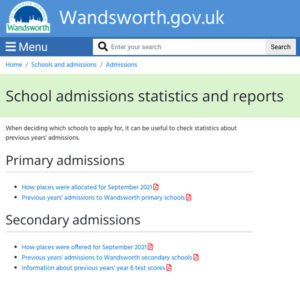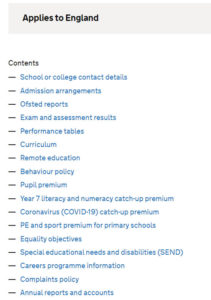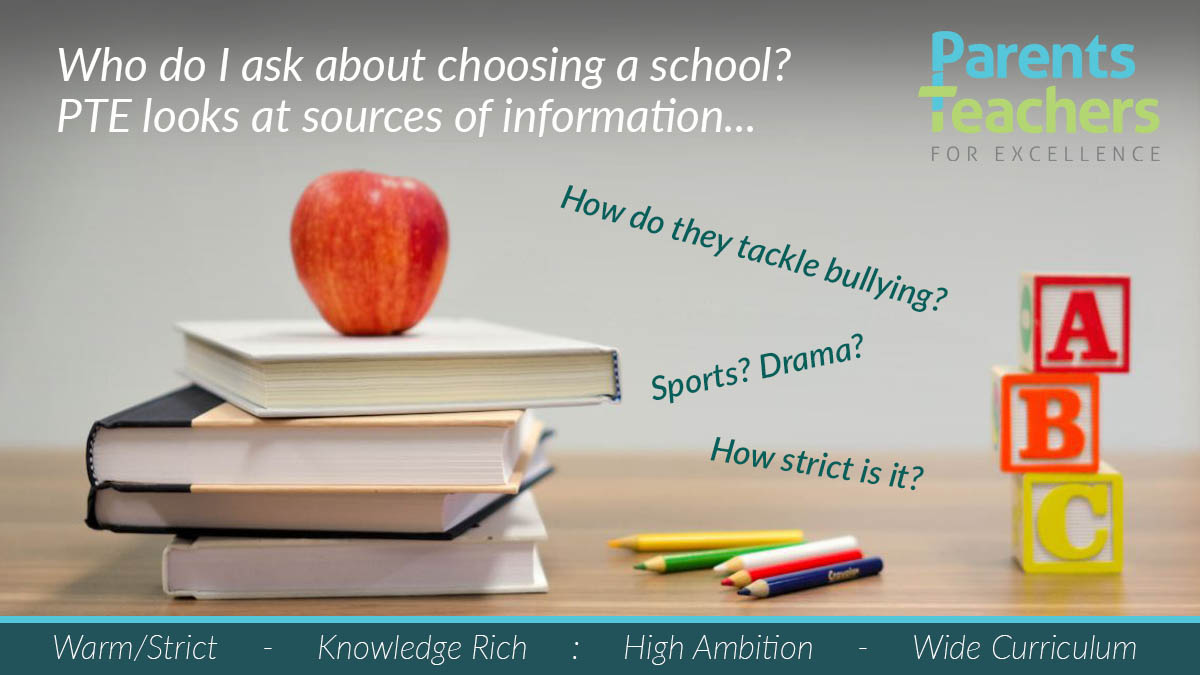Choosing a School: Sources of Information
In the last piece we covered a couple of “formal” datasets about schools – the government’s Performance Tables, and Ofsted’s inspection report.
In this article we are going to cover three other really important sources of information that families can use to come up with a shortlist of school preferences:
- Recent applications data
- School websites, and
- Local word-of-mouth
Again though, like all information on schools it’s really important to not let any one thing put you off or encourage you too much.
Remember: one parent’s “too strict” is another’s “safe and orderly”. And people with axes to grind tend to be more vocal than those who are content with things, so shared views tend to be skewed.
Recent applications data
Every local authority is obliged to publish admissions information every year, so that people can see how many applications each school received in previous years, and on what basis places were allocated.
To find this data for schools you’re potentially interested in, go to the council website for where the school is based, and search for the section on “schools” or “school admissions” or something similar.
Here is what Wandsworth’s looks like:

Somewhere in this section will be a document that explains how places were allocated – sometimes it’s one document covering all age ranges, sometimes there is a different one for primary and secondary schools.
The document will contain, for every school information like the total number of places on offer, how many places were given to children in care, or those with siblings, and so on. It should also list the furthest distance from school that a child lived who was offered a place:

This data means you can start to get a sense as to how places are allocated if a school is oversubscribed, and thus how likely you are to get a place if you apply.
Don’t let a school being over or undersubscribed put you off. Often this is simply down to the makeup of the local population and not how good or popular a place is.
A few years ago there was a baby boom working its way through primary schools, and many areas simply didn’t have quite enough places to go around, so every school was oversubscribed, regardless of quality. That bulge is now working its way through to the secondary phase, and so a similar thing is happening there, and some really great primary schools are now finding themselves undersubscribed for the first time in ages.
So this data can be helpful, but isn’t definitive by any means…
School websites
These days every school in the land must have a website, and there are rules as to what they must publish on it. There’s quite a lengthy list of things that should be available – you can find it here.

Obviously a website is a chance for a school to project how they’d like to be seen, and isn’t necessarily how things are in reality. That said, you can get a flavour of the place from the kinds of things they emphasise and the tone they use.
You should also be able to get a proper sense of the most important elements that make great schools great: their philosophy and approach towards the culture and curriculum.
Do they talk (write) about expecting the highest standards of conduct from pupils? Is there a mention of the importance of academic rigour for all, or a knowledge-rich curriculum, or the best that’s been thought, said, and done?
How much is made of the wider curriculum opportunities organised for pupils – and are these built into the school day or put on out-of-hours?
Again, no one thing should put you off or win you over – but some time browsing websites will give you a better idea of priorities. It will also inform questions you ask when you visit.
Word-of-mouth
If you haven’t already started to talk to people about local schools, once you do you will discover that nearly everyone has views on them, and pretty firm views too!
However, it’s really important to weigh up the validity of what people tell you. Everyone has a different view as to what makes a great school great, and it’s what you think in this regard that matters most. So when someone is negative or positive about a place, try to find out exactly what it is that informs that, so you can decide if you would feel the same way or differently.
Also, it’s really important to get views from people with current experience of a school.
So much can change in a year, or with a new Headteacher or academy trust running the place. Things that were a strength or weakness a while back might not be now – and only current families of the school will be able to tell you how it is today.
If they exist, community or even school Facebook pages can be really good sources of intelligence. If you feel confident enough to do so, posting questions on here about things that matter most to you will probably yield a lot of responses. There are also forums like Mumsnet where you can get anonymous information from other parents.
And as with all word-of-mouth stuff, don’t forget that bad news is loudest and content parents and pupils tend not to broadcast their happiness – so don’t put too much emphasis on negative stories, unless you can corroborate them yourself, or see how things are in the school itself.
Overall then, you won’t be short for information and opinions. The key is to filter out things that aren’t important to you, and keep focused on the stuff that really matters: pupil behaviour, the curriculum, and how they work with families when things go wrong or need discussing.
Once you’ve scanned Ofsted reports and performance tables, chatted to some families who attend places, and figured out which schools you can reasonably hope to get into, you’ll have a pretty good idea of which schools you should visit. And that’s where the real fun begins!
